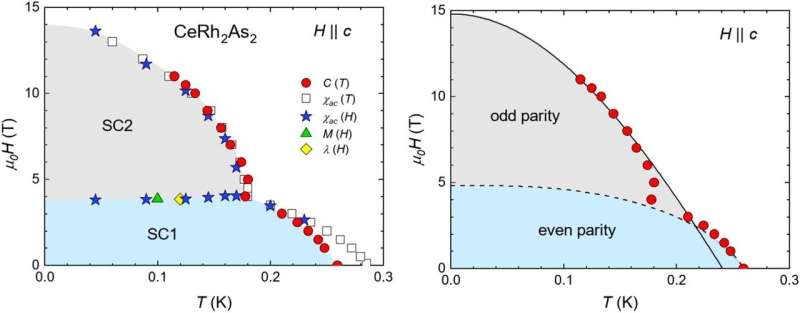New superconducting material found

The phenomenon of superconductivity, providing current transmission without dissipation and a host of unique magnetic properties arising from macroscopic quantum coherence, was first discovered over a century ago. It was not understood until 1957, after which it quickly became clear that superconductors could in principle exist with a wide variety of the fundamental characteristic often referred to as the order parameter. Until the late 1970s, however, all superconductors found experimentally had the same class of order parameter.
Since then many aspects of the expected variety of order parameters have been discovered, but one surprising fact remained. A common characteristic of non-standard, or "unconventional" order parameters is that the superconductor should be simultaneously very close to more than one of them, and that it should be possible to tune from one to the other by making fairly small changes to the conditions such as temperature, pressure or magnetic field. Although tens of unconventional superconductors have been discovered in the past half century, there was good thermodynamic evidence of more than one superconducting phase in only one or two materials.
The recent discovery of two-phase superconductivity in CeRh2As2 by members of the Max Planck Institute for Chemical Physics of Solids (MPI CPfS Dresden) is therefore a major milestone in the field.
A collaboration led by Seunghyun Khim and Christoph Geibel of the Physics of Quantum Materials department and Elena Hassinger of the Physics of Unconventional Metals and Superconductors group, with input from the groups of Manuel Brando and Andy Mackenzie, has uncovered two key facts about the material. Firstly, CeRh2As2 has one of the highest critical magnetic field to superconducting transition temperature ratios of any known superconductor.
Secondly, as the field (when applied along a special direction relative to the crystal axes) is raised, there is a clear transition between two different superconducting order parameters, leading to signatures in various thermodynamic properties. In an international collaboration with theorists Daniel Agterberg of U. Wisconsin and Philip Brydon of U. Otago, they further showed that this can be understood in terms of a special combination of local and global symmetries which occur in CeRh2As2 but not in any other superconducting material discovered so far.
The findings, published online on 26 August 2021 by Science magazine, can be expected to generate entirely new research directions; indeed several theory papers from groups around the world have already appeared based on the archived preprint describing our research.
More information: Alexandre Pourret et al, Driving multiphase superconductivity, Science (2021). DOI: 10.1126/science.abj8193
Journal information: Science
Provided by Max Planck Society





















